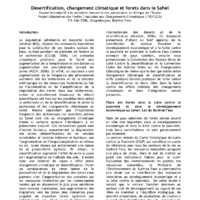Recherche
5 items
Decision support note on Mobile Livestock Systems (MLS) in West Africa and' the Sahel (WAS)
This decision support note is the second to materialize the operationalization of the Observatory of Mobile Livestock Systems in West Africa and the Sahel (OSEMAOS); an information platform piloted by the AGRHYMET Regional Center of CILSS in collaboration with ECOWAS and WAEMU. It deals with the pastoral situation from June to November 2024 based on data and informations transmitted by the focal points of the countries, by the Professional Organizations of breeders, pastoralists and farmers, local and cross-borderinter-communities.
Ensuring peaceful livestock mobility
Livestock farming plays a central role in the national and regional economies of West
Africa. It accounts for up to 10-15% of the GDP of the Sahelian states1 and contributes
to the local economies of the host areas of transhumant livestock farmers2. It is a major
source of income and employment throughout the sector, providing up to 99% of the red
meat consumed in the sub-region. Pastoral and agropastoral livestock farming systems,
based on the mobility of livestock, are still largely dominant in the sub-region. Several
regional pastoral development initiatives, such as the Projet régional d’appui au
pastoralisme au Sahel or Sahel Regional Pastoralism Support Project (PRAPS), the
Projet régional de dialogue et d’investissement pour le pastoralisme et la transhumance au Sahel et dans les pays côtiers de l’Afrique de l’Ouest or Regional dialogue and Investment Project for Pastoralism and Transhumance in the Sahel and Coastal Countries of West Africa (PREDIP) and the Projet Elevages et pastoralisme intégrés et sécurisés en Afrique de l’Ouest or Integrated and Secure Livestock Production systems and Pastoralism in West Africa Project (PEPISAO), have been developed and implemented by the Permanent Inter-state Committee for Drought Control in the Sahel (CILSS).
Impacts of climate change over forest ecosystems and related vulnerability
La fonction et la structure des écosystèmes forestiers sont en partie déterminées par les conditions climatiques environnantes. La distribution des précipitations et la moyenne des températures définissent le type d'écosystème forestier d’un milieu. Par conséquent, les changements climatiques influencent les forêts et partant entraîne des changements dans la production de produits et services importants pour la société. Cet article présente une brève introduction à ce sujet
Products for capitalizing on experiences and acquired knowledge of PREDIP
Livestock farmers in West Africa and the Sahel lack access to sufficient information on seasonal weather forecasts, fodder resource availability, livestock market situation, and health and security situation. The aim of the Regional Pastoral Information Service
(SRIP), PREDIP project Component 1, is to improve farmers’ access to reliable technical information tailored to their needs, so that they can optimise their tactical and strategic herd management choices and reduce the risk of conflict with farmers. The information produced as part of the implementation of the SRIP reaches farmers via social networks, call centres and community radio stations. One of the SRIP’s experiments involved the production of interactive programmes by community radio stations. This note capitalises on the experience of radio broadcasts in the regions of Dosso and Maradi in Niger. The themes of the interactive programmes were chosen on the basis of the information needs identified amongst livestock farmers following a preliminary survey
carried out by AGHYMET CCR-AOS, the PREDIP technical focal points and the community radio coordinators. Broadcasts were made in the local languages of these regions. A total of 99 programmes were produced and broadcast by radio stations in 26 communes, including 14 in Dosso and 13 in Maradi. These programmes were broadcast 3,150 times, with an average of 200 editors per programme. Following the broadcasts, a field mission was carried out to assess the impact of the programmes. It turned out that
the broadcasts had made a significant contribution to the timely reception of information and to improving listeners’ knowledge. This has raised awareness, leading to better cohabitation between farmers and herders and calmer transhumance. The professionalism of the community radio stations, the support of the various partners and local authorities, the effective participation of farmers’ associations and the involvement of youth clubs played a key role in the success of these broadcasts. However, the lack of financial and material resources was one of the difficulties encountered by the radio stations. Farmers also complained about the short duration of the broadcasts. In view of these difficulties, partnerships with other radio stations,
extending the duration of broadcasts, and technical and financial support are solutions that have been adopted or are being considered to improve the success and sustainability of the broadcasts.
What are the prospects for the evolution of mobile livestock systems in relation to the ongoing political, technological and social mutations in West Africa and the Sahel? Thematic Reflection Note 3 June 2021
PEPISAO aims to strengthen the capacities of States and regional and national actors so that they can develop approaches to secure livestock mobility and integrate livestock farming methods in line with a shared regional vision and offering maximum guarantees for the peaceful cohabitation of different users of natural resources. In order to achieve this ambition, the ECOWAS Commission, in collaboration with UEMOA and CILSS, has initiated a prospective reflection on mobile livestock systems. Such an exercise reflects an anticipatory approach based on the analysis of relevant factors of change for the future of livestock systems. The present note, which is part of this exercise, aims to characterise the socio-political dynamics at work in the region, in relation to mobile livestock systems. The link between anticipation and strategic planning is tenuous. Moreover, the challenge of exploring the likely future of transhumance and consequently the future of millions of people - development actors in their own right of territories for which they are overlooked - is of crucial importance for regional integration and stability of the region and for peaceful cohabitation between socio-cultural groups. Studies, regional programmes and high-level meetings have multiplied in recent years, reflecting both the acuteness of the issue for the various actors and the complexity of the process of constructing political and social arrangements at the relevant levels of decision-making and action in the areas concerned by these problems.

